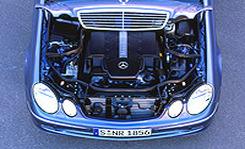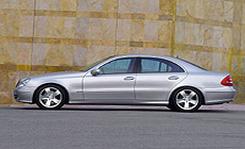
 First Drive Review
First Drive Review
Time has been gentle to the current Mercedes-Benz E-class. Ripened to senior status by seven busy years on the market, the E's stately bearing and handsome four-moon face can still beguile enough souls worldwide to annually separate about 200,000 of them from their wages. Their ranks comprised 18 percent of Mercedes' worldwide passenger-car customers last year, placing the E-class in the very keel of the company's 100-year-old ship.
Pity those who were put in charge of the $1,750,000,000 budget to replace the W210, as Mercedes calls the current E. The model's importance, plus the fact that E-class variants must bridge the socioeconomic canyon separating diesel taxis from luxury autobahn inhalers, must have hung like so many boat anchors around their necks. However, all things must pass, and considering that the outgoing E430 managed no better than fifth place in our "Lucky Seven" shootout (September 2001) of highfalutin V-8s, the W210 was certainly due for relief.
Not surprisingly, Mercedes chose evolution over astonishment as the theme for its redesign. "One of the challenges was to convince the current E-class customer that this is a new car, but make it familiar enough so they will feel comfortable in it," says Bernd Harloff, director of E-class development.


So in the W211, which began production in March and will roll into U.S. showrooms in September starting with the 221-hp, 3.2-liter V-6 and the 302-hp, 5.0-liter V-8 (wagon and 4Matic versions arrive within a year), the E-class's familiar four eyes remain, but they are blasted by the wind tunnel into canted ellipses that resemble neither the C-class twin peanuts nor the S-class snoozing larvae. Sadly, the perky fender tunnels that, as on an old Porsche 911, once defined the view over the hood have been flattened in the name of a 0.26 drag coefficient.
The rest of the body, especially the arched roof, swooping C-pillars, and conspicuously flaring wheel arches, closely adheres to Mercedes' current "coupe with extra doors" motif. Dimensional changes mostly round to zero, and the footprint remains mere whiskers off a Toyota Camry's. The 112.4-inch wheelbase does represent 0.9 inch of swell from the old E, with the space benefiting the front-seat passengers. Trunk volume also grows, thanks to a decision to relocate the 19.5-gallon fuel tank from behind the rear seat to below it. Thus, folding rear seats also debut as a plebeian option.


With a 3665-pound test weight, the old E430 comparo car was lighter than its competitors--even the vaunted BMW 540i--by 150 to 400 pounds, and engineers were charged with preserving the advantage. The new E's hood, front fenders, trunk, and parcel shelf are all stamped in aluminum, as is the front-bumper structure. However, structural reinforcements to improve rigidity and crash performance mean the new body shell is actually heavier than the old model's.